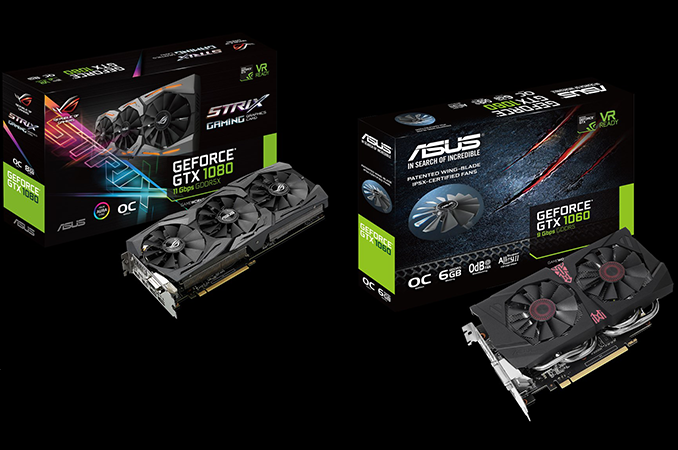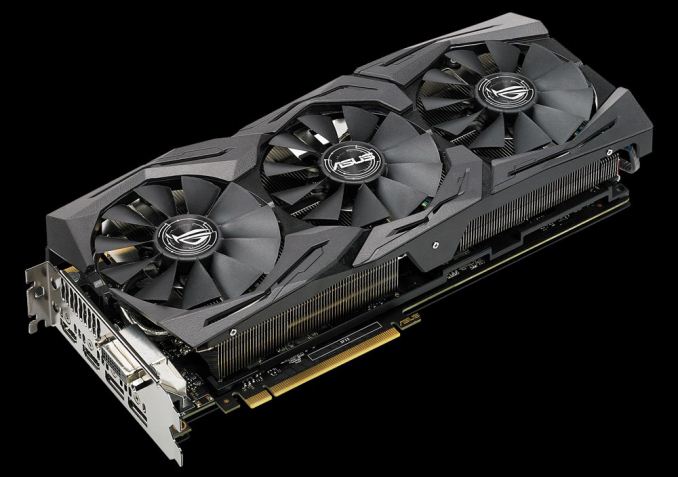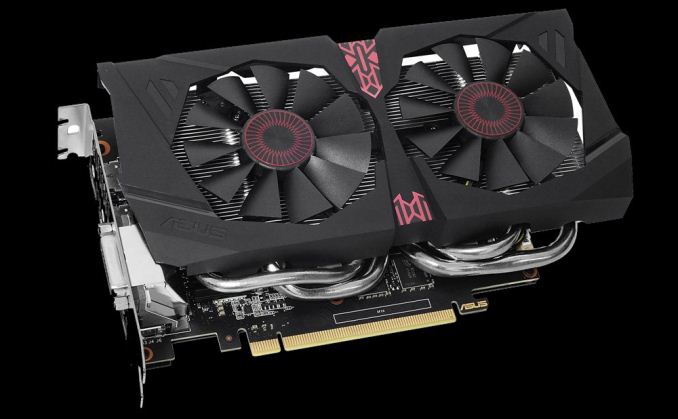ASUS Launches GeForce GTX 1080 & GTX 1060 Models With Faster RAM
by Anton Shilov on April 11, 2017 2:00 PM EST
ASUS has released graphics cards based on NVIDIA’s GeForce GTX 1060 and 1080 GPUs that are equipped with faster memory. The new add-in-boards (AIBs) are designed to offer greater performance in high resolutions than reference designs and enable ASUS to charge a premium for the higher FPS.
Back in February when NVIDIA cut the price on the GTX 1080, the company also announced that they would be working with partners to sell factory overclocked cards with higher speed grades of memory. At launch the fastest grades available for the GTX 1080 and GTX 1060 were 10Gbps GDDR5X and 8Gbps GDDR5 respectively; however in the last year, 11Gbps GDDR5X and 9Gbps GDDR5 have become available. Now those faster memory grades are being made available to their partners for use in factory overclocked cards, giving partners more configuration options for their factory overclocked SKUs.
For partners, this marks their first real opportunity to sell cards with memory overclocks. While NVIDIA’s GPUs have been able to support these higher speeds, the stock configurations for the GTX 1080 and GTX 1060 were already pushing their respective RAM types to their limit, leaving partners no real headroom for the kind of stable and consistent overclocks required for factory overclocking.
At a hardware level, things are pretty straightforward for GTX 1080 cards; vendors can now grab Micron’s 11Gbps GDDR5X chips and use them in the place of 10Gbps chips. Things are a bit less clear on the source of the GDDR5 however. The only manufacturer with an official 9Gbps part listed is Samsung, whose K4G41325FE is still at the "Customer Sample" phase. More importantly however, that chip is only offered in a 4Gb density, whereas NVIDIA has used 8Gb chips for both the GTX 1080 and GTX 1060 6GB. So it will be interesting to see just how 9Gbps GTX 1060s are equipped.
Now, back to ASUS’ GeForce GTX 10 cards with faster memory. At present, the company offers two of such boards: the ROG Strix GeForce GTX 1080 OC Edition 8 GB 11 Gbps as well as the ASUS GeForce GTX 1060 OC Edition 6 GB 9 Gbps. The two AIBs belong to different classes of products, but in both cases ASUS did something more than just soldered faster memory chips to PCBs.
The ASUS ROG Strix GeForce GTX 1080 OC Edition 11 Gbps GDDR5X is based on the company’s proprietary PCB design with an 8+2 phase VRM, one 6-pin and one 8-pin PCIe power connectors. The enhanced power supply circuitry and an additional power connector enable ASUS to increase GPU and memory frequencies from those recommended by NVIDIA and ensure some additional headroom for end-user overclocking. Meanwhile, ASUS does not disclose exact GPU clock rates of its flagship GeForce GTX 1080, which means that the company is still finalizing them.
To ensure proper cooling of the GPU, VRM and memory, ASUS equips its ROG Strix GeForce GTX 1080 OC Edition 11 Gbps with a 2.5-wide cooling system featuring six heat pipes and three fans (which stop rotating at low GPU temperatures). As an added bonus, the cooler features ASUS’ user-controllable Aura Sync RGB lighting.
The ASUS GeForce GTX 1060 OC Edition 6 GB 9 Gbps also uses ASUS’ own PCB as well as the company’s DirectCU II cooling system with four heatpipes and two fans. Obviously, since this is an OC Edition AIB, its GPU frequency is higher than that on reference cards, but ASUS does not publish it. The card does not belong to the ROG or the Strix families, it is not the top-of-the-range GeForce GTX 1060 from ASUS, so expect company to offer something faster based on the GP106 GPU over time.
| Specifications of ASUS GeForce GTX 1080 11 Gbps and GTX 1060 9 Gbps | ||||||||
| ASUS ROG Strix GeForce GTX 1080 OC Edition 11 Gbps |
NVIDIA GeForce GTX 1080 Founders Edition |
ASUS GeForce GTX 1060 OC Edition 9 Gbps |
NVIDIA GeForce GTX 1060 Founders Edition |
|||||
| Stream Processors | 2560 | 1280 | ||||||
| Texture Units | 160 | 80 | ||||||
| ROPs | 64 | 48 | ||||||
| Core Clock (MHz) | 1670 - 1695 (?) | 1607 | 1506 - 1531 (?) | 1506 | ||||
| Boost Clock (MHz) | 1809 - 1835 (?) | 1733 | 1708 - 1746 (?) | 1708 | ||||
| Memory | Capacity | 8 GB | 6 GB | |||||
| Type | GDDR5X | GDDR5 | ||||||
| Clock | 11 Gbps | 10 Gbps | 9 Gbps | 8 Gbps | ||||
| Power | 1×8-pin PCIe 1×6-pin PCIe >180 W |
1×8-pin PCIe 180 W |
1×6-pin PCIe ~150 W |
150 W | ||||
| VRM | 8+2 phases | 5+1 phases | ? | 3+1 phases | ||||
| PN, Additional Details | ROG-STRIX-GTX1080-O8G-11GBPS | - | GTX1060-O6G-9GBPS | - | ||||
| Launch Date | Q2-2017 | 5/2016 | Q2-2017 | 8/2016 | ||||
| Launch Price | ? | $699 | ? | $449 | ||||
ASUS has not announced MSRPs for its GeForce GTX 1080 11 Gbps and GeForce GTX 1060 6 GB 9 Gbps products, but since they are listed on its website, they are going to show up on shelves soon and thus prices will be revealed. As usual, bear in mind that prices will vary depending on the region.
Related Reading:
- ASUS Demonstrates ROG Swift PG27UQ: 4K, 144 Hz, HDR, DCI-P3 and G-Sync
- GeForce GTX 1080 Price Cut to $499; NVIDIA Partners To Begin Selling 10-Series Cards With Faster Memory
- The NVIDIA GeForce GTX 1080 Ti Founder's Edition Review: Bigger Pascal for Better Performance
- NVIDIA Announces NVIDIA Titan Xp Video Card: Fully Enabled GP102 for $1200
Source: ASUS

























20 Comments
View All Comments
MrSpadge - Wednesday, April 12, 2017 - link
http://www.anandtech.com/show/10325/the-nvidia-gef...In 3 of 5 games benchmarked in 4k resolution the memory OC yielded about half as much performance as a comparable GPU OC. Sure, that's less, but far from the 1:8 ratio you suggest.
bcronce - Wednesday, April 12, 2017 - link
For the CPU bound games, yes. 3% gain on the high end, 1% typical.Yojimbo - Tuesday, April 11, 2017 - link
You have the 1070 launch price listed under the 1060 launch price field. The 1060 Founder's Edition launched for $299.AlMt - Tuesday, April 11, 2017 - link
From what I see on the internet, the better quality 1060 cards (ASUS, MSI, maybe others) seem to be able to reach 9+ GHz with ease - or at least very many of them do. My 1060 Gaming X does 9.4 (a +700 offset to memory - can go as high as +780 before ECC errors, but prefer the slightly lower OC to be more certain about stability) - lucky I suppose, but it seems like it's not rare at all for these types of cards. I wondered why they don't all come with 9 GHz from the factory since it seems it's quite easy to achieve.MrSpadge - Tuesday, April 11, 2017 - link
With a maximum OC there is no safety margin left. The manufacturer needs to provide more margin than a home user typically needs: they need to work at guaranteed extremly low error rates, at elevated temperatures for several years. So if they choose 9 Gbps at the factory, overclockers should reach anywhere between 9.5 and 10 Gbps.AlMt - Tuesday, April 11, 2017 - link
Makes sense. But I think I rembember reading that these overbuilt 1060s had the same RAM chips as the 1070, just clocked lower (which probably explains the large OCs). So they probably more or less had it in them all along.MrSpadge - Wednesday, April 12, 2017 - link
Yes, they have the same chips. But not clocked lower: 1070 and 1060 both have 8 Gbps GDDR5 stock. And both OC well.Diji1 - Wednesday, April 12, 2017 - link
Are we going to see GTX 1070's with the faster RAM?It will be interesting to see how these card perform especially considering the large performance gains that were seen from the modest overclocking of the previous RAM.
Wulfrig - Thursday, April 27, 2017 - link
When is this new gtx 1080 launching? It said 20th-25th april everywhere i read but i don't see it for sale yet.. I only saw the MSI model but in europe :/ Anyone knows? I'm waiting for it to launch so i can buy it!